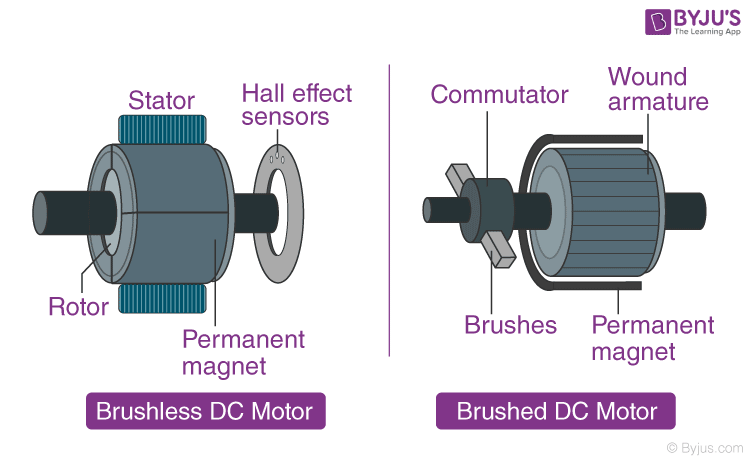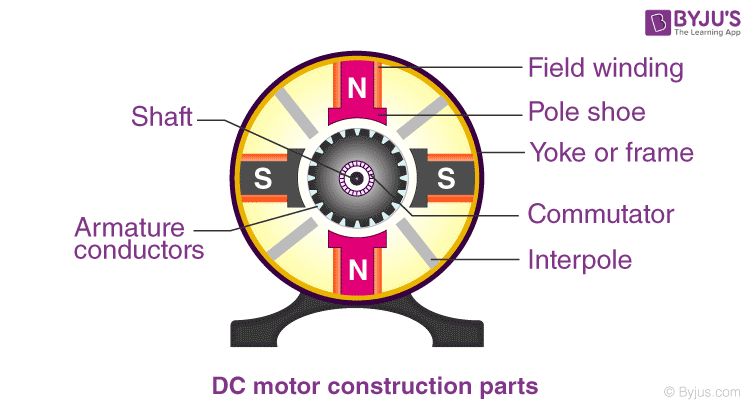A DC motor is an electrical machine that converts electrical energy into mechanical energy. In a DC motor, the input electrical energy is the direct current which is transformed into the mechanical rotation. In this session, let us know what is a DC motor, types of DC motor and their applications.
| Table of Contents: |
What is a DC Motor?
A DC motor is defined as a class of electrical motors that convert direct current electrical energy into mechanical energy.
From the above definition, we can conclude that any electric motor that is operated using direct current or DC is called a DC motor. We will understand the DC motor construction and how a DC motor converts the supplied DC electrical energy into mechanical energy in the next few sections.
DC Motor Diagram
Different Parts of a DC Motor
A DC motor is composed of the following main parts::
Armature or Rotor
The armature of a DC motor is a cylinder of magnetic laminations that are insulated from one another. The armature is perpendicular to the axis of the cylinder. The armature is a rotating part that rotates on its axis and is separated from the field coil by an air gap.
Field Coil or Stator
A DC motor field coil is a non-moving part on which winding is wound to produce a magnetic field. This electro-magnet has a cylindrical cavity between its poles.
Commutator and Brushes
Commutator
The commutator of a DC motor is a cylindrical structure that is made of copper segments stacked together but insulated from each other using mica. The primary function of a commutator is to supply electrical current to the armature winding.
Brushes
The brushes of a DC motor are made with graphite and carbon structure. These brushes conduct electric current from the external circuit to the rotating commutator. Hence, we come to understand that the commutator and the brush unit are concerned with transmitting the power from the static electrical circuit to the mechanically rotating region or the rotor.
DC Motor Working
In the previous section, we discussed the various components of a DC motor. Now, using this knowledge let us understand the working of DC motors.
A magnetic field arises in the air gap when the field coil of the DC motor is energised. The created magnetic field is in the direction of the radii of the armature. The magnetic field enters the armature from the North pole side of the field coil and “exits” the armature from the field coil’s South pole side.

The conductors located on the other pole are subjected to a force of the same intensity but in the opposite direction. These two opposing forces create a torque that causes the motor armature to rotate.
|
Working principle of DC motor When kept in a magnetic field, a current-carrying conductor gains torque and develops a tendency to move. In short, when electric fields and magnetic fields interact, a mechanical force arises. This is the principle on which the DC motors work. |
|
Similar Reading |
Types of DC motor
DC motors have a wide range of applications ranging from electric shavers to automobiles. To cater to this wide range of applications, they are classified into different types based on the field winding connections to the armature as:
- Self Excited DC Motor
- Separately Excited DC Motor
Now, let us discuss the various types of DC Motors in detail.
Self Excited DC Motor
In self-excited DC motors, the field winding is connected either in series or parallel to the armature winding. Based on this, the self-excited DC motor can further be classified as:
- Shunt wound DC motor
- Series wound DC motor
- Compound wound DC motor
Shunt wound DC motor

In a shunt wound motor, the field winding is connected parallel to the armature as shown in the figure.
Series wound DC motor

In a series wound DC motor, the field winding is connected in series with the armature winding as shown in the figure.
Compound wound DC motor

DC motors having both shunt and series field winding is known as Compound DC motor, as shown in the figure. The compound motor is further divided into:
- Cumulative Compound Motor
- Differential Compound Motor
In a cumulative compound motor, the magnetic flux produced by both the windings is in the same direction. In a differential compound motor, the flux produced by the series field windings is opposite to the flux produced by the shunt field winding.
Separately Excited DC Motor

In a separately excited DC motor, the field coils are energised from an external source of DC supply as shown in the figure.
Brushed DC Motor vs Brushless DC Motor

A brushless DC motor, also known as synchronous DC motor, unlike brushed DC motors, do not have a commutator. The commutator in a brushless DC motor is replaced by an electronic servomechanism that can detect and adjust the angle of the rotor.
A brushed DC motor features a commutator that reverses the current every half cycle and creates single direction torque. While brushed DC motors remain popular, many have been phased out for more efficient brushless models in recent years.
Applications of DC Motor
The applications of different types of DC motors are listed below:
Shunt DC Motors
Owing to the fairly constant speed and medium starting torque of shunt DC motors, they are used in the following applications:
- Centrifugal and reciprocating pumps
- Lathe machines
- Blowers and Fans
- Drilling machines
- Milling machines
- Machine tools
Series DC Motors
Owing to the high starting torque and variable speed of series DC motors, they are used in the following applications:
- Conveyors
- Hoists, Elevators
- Cranes
- Electric Locomotives
Cumulative Compound DC motors
Owing to the high starting torque of cumulative compound DC motors, they are used in the following applications:
- Shears
- Heavy Planers
- Rolling mills
- Elevators
Frequently Asked Questions on DC Motor
Can a DC motor run on AC?
What is a Universal motor?
When is a DC motor preferred over an AC motor?
- When precise control is needed, DC motors offer a wide range of possibilities concerning speed control. Due to this reason, industrial machinery that requires high precision works with DC motors.
- DC motors offer excellent response characteristics when starting, stopping and reversing their spin direction.
- The energy stored in the batteries of electric vehicles is in the form of DC. Hence, DC motors are compatible with electric vehicles.
When was the DC motor invented?
Why are DC ceiling fans better?
- DC motor fans use 70% less energy than a standard AC fan.
- DC motor fans are less noisy.
- DC motor fans have more speed options than an AC motor fan.
Stay tuned to BYJU’S and Fall in Love with Learning!

